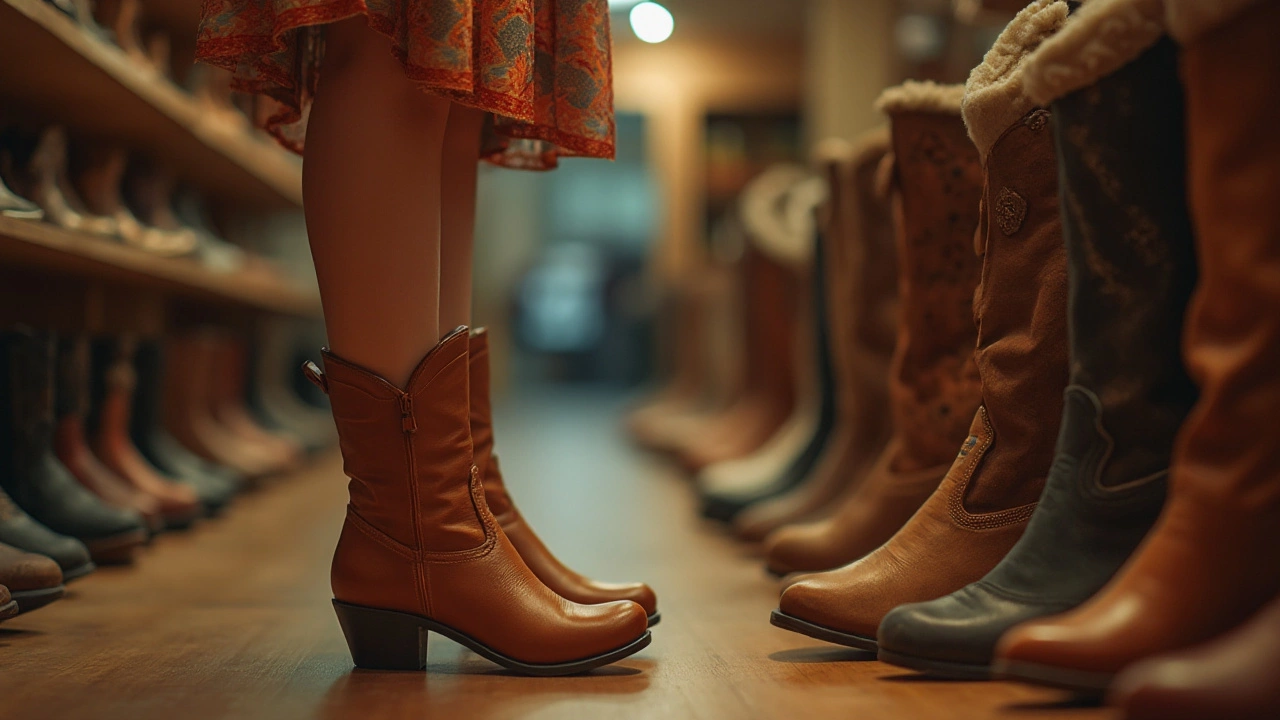Navigating the world of women's boots can be a complex endeavor, particularly when it comes to getting the right size. Unlike sneakers or sandals, boots often come with unique challenges that relate to their design and the materials used. Simply wearing your regular shoe size doesn't always guarantee the ideal fit, leading many shoppers to wonder if they should size up.
Understanding why sizing varies and learning how to make the right choice can save you from discomfort and impractical purchases. Whether you're eyeing those chic knee-high leather boots or the rugged allure of hiking boots, knowing how to assess boot fit accurately is key to making a wise purchase. Let's explore what you should consider before buying your next pair of boots and how to avoid common pitfalls.
- Understanding Boot Sizing
- Factors Influencing Boot Size
- Tips for Finding the Right Fit
- Common Sizing Mistakes to Avoid
Understanding Boot Sizing
In the vast world of footwear, boot sizing can sometimes feel like a labyrinth. Different factors contribute to how boots fit, and it often begins with understanding the basic measurements that define sizing. Contrary to common belief, a size 7 in one footwear line doesn't necessarily translate to the same fit in another, especially when we bring diverse boot designs into the mix. Manufacturers use varying lasts, which are molds used to shape a boot, influencing its final fit. So, while you might be a size 8 in sneakers, boots with narrow lasts might require you to size up.
Furthermore, the advent of international markets means size charts can vary significantly across regions. A UK size 5 does not equate to a US size 5. This disparity can cause a lot of confusion. Most brands offer sizing guides to bridge this gap, yet many buyers neglect these resources, leading to misfit boots that are either too snug or too loose. Heather Heron, a notable footwear designer, once mentioned,
"The right boot should fit like a good pair of jeans—snug enough to show off but comfortable enough for moving."Her advice couldn't be more relevant, especially as we consider the myriad of factors influencing boot sizing.
Another subtlety in women's boots sizing lies in the style of the boot itself. Ankle boots might have more forgiving fits compared to their knee-high counterparts, which can require more precise measurements, particularly around the calf area. For instance, if you're inclined toward cowboy boots, remember that these often run larger to allow for easy slipping on and off. Conversely, dress boots tend to run a tad smaller for a sleek fit with formal attire. Every style tells its own story, and part of understanding sizing is aligning with the style's narrative.
Materials too play a significant role in sizing decisions. Leather boots, known for their durability, also stretch over time, providing a little leeway if they're initially tight. On the other hand, synthetic materials might not offer the same flexibility, making precise sizing more critical right from the start. A useful tip often shared by boot enthusiasts is to always account for the socks you'll be wearing. A bulky winter sock can change the fit dynamics considerably, transforming what felt perfect with a thin sock into an uncomfortable squeeze.
Common Misunderstandings
Misunderstandings about sizing often arise from misinterpretations of 'breaking in' boots. While most leather and high-quality boots need a period to mold to your feet, buying boots too small under the guise that they'll stretch could lead to discomfort and even pain. It's essential to ensure that there's enough room at the toe and enough grip at the heel right from the start, preventing potential long-term foot issues.
Ultimately, understanding boot sizing goes beyond mere numbers. It's about considering factors like design, materials, sock thickness, and personal comfort preferences. Each purchase is a step towards not only enhancing your wardrobe but also investing in your comfort and confidence as you stride through life. So take the time, consult the size charts, and if possible, try before you buy, because the right pair of boots is more than just a fashion statement – it's an ally in both your journeys and destinations.

Factors Influencing Boot Size
When venturing into the realm of women's boots, understanding the nuances of sizing is crucial. Various factors can influence why one might choose to size up or down. The design of the boot can significantly impact fit. For example, ankle boots, which end at or above the ankle, tend to have a more standardized fit. In contrast, knee-high or over-the-knee boots can vary widely depending on the tapering of the shaft and the material's stretchiness. It's not uncommon for women to size up in these types to accommodate their calves, which might be a snug fit otherwise.
Materials also play a pivotal role. Leather, a popular choice for many boot styles, has the ability to stretch slightly over time, offering a more custom fit after repeated wear. However, this stretching is not as pronounced in synthetic materials. Boot linings can add bulk and reduce the interior space of a boot, leading many to size up to ensure comfort. Lining types, such as shearling, can drastically alter how a boot feels, especially in colder climates where thicker socks are worn.
Another factor is the boot's intended use. Footwear tips suggest considering the boot's purpose — fashion, work, or hiking. For instance, work boots often require additional space for thicker job site socks or insoles for comfort, prompting a sizing adjustment. Likewise, hiking boots need room for proper circulation and swelling during long treks.
“Finding the right fit in a boot is as much about the activity as it is about the boot itself,” says renowned footwear expert, Dr. Rebecca Wilmoth.
Seasonal changes and foot swelling are other considerations. Feet tend to expand slightly in warmer months, and some individuals experience daily swelling, especially those who spend long hours on their feet. This natural change often leads buyers to seek a slightly larger size for comfortable wear throughout the year. Additionally, the type of socks worn can create the need for a size adjustment. Thin socks may allow for a true-to-size fit, while heavy, cushioned socks may necessitate a size up for added comfort.
The Role of Brand and Make
Boot sizing isn't universal. Each brand has unique sizing charts and manufacturing standards that can affect fit. A size 8 in one brand might fit like a size 9 in another. Trying on several sizes and styles is advised unless you're familiar with a brand's specific fit. Consulting size charts and user reviews online provides additional insights. Called "vanity sizing," some brands design their boots with a looser fit to avoid potential customer returns, which can lead to a habit of incorrectly adjusting one's perceived fit.
Finally, individual foot shape is vital in determining boot size. No two feet are the same, with differences in width, arch height, and toe shape. Brands offering wide or narrow options offer alternatives, ensuring everyone has the opportunity to find their perfect fit. Thinking about foot shape and alignment when selecting a size can prevent not only discomfort but also long-term foot health issues.

Tips for Finding the Right Fit
Finding the perfect fitting pair of women's boots is akin to finding the right partner. It's not just about initial attraction; it's about compatibility and comfort that lasts. When searching for the right pair, it’s crucial to consider your foot's unique shape and how different styles and materials of boots can impact fit. For starters, always try on boots at the end of the day. During these late hours, your feet are usually at their largest due to natural swelling, giving you a realistic feel of how the boots will fit over extended periods. Consider trying boots with the socks you plan to wear them with most often, ensuring that what seems snug at first doesn't become unbearable later.
Pay close attention to the boot's width versus your own, as not all boots are made with width variations even if the length fits perfectly. If you often find yourself between sizes, don’t shy away from trying a half-size larger or a model with adjustable features such as buckles or laces. For particular types of boot sizing, like hiking or snow boots, which might require room for additional or thicker socks, you may benefit from sizing up a bit. An expertly curated advice from Emma Gladstone, a top footwear expert, sheds light on the matter,
“The biggest mistake people make is not accounting for foot expansion with temperature or activity level. A well-fitted boot will accommodate this without compromising comfort.”
To guarantee a smart purchase, spend time walking around in the store with both boots on. Pay attention to heel slippage. A slight heel movement is acceptable, but anything more could cause blisters. Always walk on different surfaces if possible to test the sole grip and flexibility. Don't forget to test the ankle support by moving your feet in different directions. This is particularly crucial for styles intended for more than casual strutting around. Remember, boots that feel rigid or don’t flex well will only become more uncomfortable over time.
Consider the boot material, as it can play a significant role in how they fit over time. Leather and suede styles may stretch and mold to your foot shape as you break them in, whereas synthetic materials might not give as much. If you score a slightly tight leather boot that you love, you could take efforts to stretch them gently at home. Use shoe stretchers or employ professional stretching if needed. This process allows you to grow into the boot rather than risk an oversized fit that never feels quite right.
Finally, remember that not all brands size their footwear in exactly the same way, so it can be useful to check size conversion charts if you’re purchasing online or trying a foreign brand. An understanding of different sizing standards and a consideration for the nuances of each material and style is crucial in securing a comfortable and stylish fit. Don't rush through the process; your feet will thank you for the careful attention!

Common Sizing Mistakes to Avoid
When embarking on the search for the perfect pair of women's boots, it’s easy to fall into a few common sizing traps. One frequent mistake is assuming all footwear brands employ standardized sizing. This is far from true, as sizes can vary considerably from one brand to another due to different manufacturing processes and demographic targets. This can lead customers to purchasing boots that don't fit as well as anticipated, leaving them uncomfortable or prone to blisters. An excellent practice is to always refer to the sizing chart provided by the brand. These charts consider the distinct measurements each boot style requires, offering more accuracy than merely choosing your usual shoe size.
An additional pitfall is overlooking the impact of sock thickness. Many people try on boots with thin fitting socks and end up disappointed when the boots become tight with thicker, winter-ready socks. This small oversight can necessitate a half size larger, especially with boots intended for cold weather use. If you're shopping for boot sizing that accommodates thicker socks, be sure to wear them during the fitting process. This simple adjustment can help you avoid uncomfortable squeezing and give a clearer sense of how the boots will feel in real-life conditions.
Another common error is underestimating the significance of the boot type’s specific design features. Different boots, from ankle boots to knee-highs, affect how sizing should be approached. For instance, shoe fit for ankle boots might focus more on the width of the foot, while knee-high boots may require careful attention to the calf circumference. Paying close attention to these aspects helps in making sure that the boots complement not only foot-size but also leg proportion. Neglecting this often leads to the disappointment of a perfect foot fit but an uncomfortably snug leg or vice versa.
A reliance on prior preconceived fits from older or worn-out footwear is also misleading. Leather boots, in particular, will relax and mold to the foot over time, often giving the false impression that the initial size was accurate. When purchasing footwear tips such as leather boots, it’s wise to ensure a slightly snug fit initially, accounting for the natural stretching that occurs with wear. An ill-fitted new boot won't transform into the desired fit over time, leading to persistent discomfort or the need for premature replacement.
Finally, forgetting seasonal foot swelling can mar even the most careful boot-sizing decisions. Feet can expand throughout the day or with warm temperatures, impacting the ideal fit. Experts often recommend shopping later in the day when feet tend to be at their largest. This practice can help ensure the boots accommodate natural fluctuations and reduce the risk of unexpected tightness during daytime wear.
In an insightful note, footwear specialist Dr. Jane Thompson suggests,
"Always prioritize fit over style when it comes to boots. A poor choice in size can lead to long-term foot issues that negate any temporary fashion gain."This highlights the importance of making informed decisions to ensure you walk not only in style but with enduring comfort.
